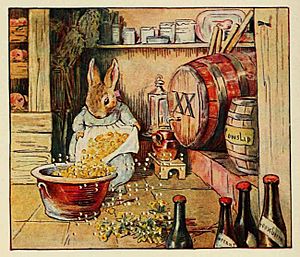Cecily Parsley's Nursery Rhymes facts for kids

First edition cover
|
|
| Author | Beatrix Potter |
|---|---|
| Illustrator | Beatrix Potter |
| Country | England |
| Language | English |
| Genre | Children's literature |
| Publisher | Frederick Warne & Co. |
|
Publication date
|
December 1922 |
| Media type | Print (Hardcover) |
| Preceded by | The Tale of Johnny Town-Mouse |
| Followed by | The Tale of Little Pig Robinson |
Cecily Parsley's Nursery Rhymes is a fun children's book by Beatrix Potter. She wrote and drew all the pictures for it! The book came out in December 1922. It's a collection of classic nursery rhymes you might know, like "Goosey Goosey Gander" and "Three Blind Mice". This was Beatrix Potter's second book of rhymes. You can even find toys and figures based on the characters from the book!
Contents
How the Book Was Made
Beatrix Potter became a famous children's author and artist in 1900. She had written a story about a rabbit in 1893. After some publishers said no, she printed her own book in 1901.
Frederick Warne & Co. had first said no to her rabbit story. But they changed their minds because they wanted to sell more children's books. They decided to publish her "bunny book," which became The Tale of Peter Rabbit. It was released on October 2, 1902.
Potter kept making books for Warne. In 1905, she moved to the Lake District in England. Her later books often featured places and animals from that area. She mostly stopped writing new books around 1913. This was because she got married, had to care for her mother, and her eyesight started to get worse.
Potter's Love for Rhymes
Beatrix Potter really loved nursery rhymes. She enjoyed changing old rhymes to include her own animal characters. Her early books, like The Tailor of Gloucester, were full of rhymes.
She liked the old ways of speaking in rhymes. She also enjoyed the puzzles and riddles that many rhymes had. Potter was inspired by Randolph Caldecott, a children's book artist she admired. He often drew animals in his rhymes.
Creating Cecily Parsley
In 1920, Potter suggested a new book of nursery rhymes to her publisher, Fruing Warne. She had collected these rhymes over many years. She wanted to call it Cecily Parsley's Nursery Rhymes. At first, Warne wasn't sure if it would sell well.
But in 1921, a librarian named Anne Carroll Moore visited Potter. Moore was very excited about the idea of a rhyme book. This made Potter feel energized, and she started working on the rhymes again. Fruing Warne then agreed to publish Cecily Parsley for Christmas 1922.
By spring 1922, Potter had rewritten the rhymes she wanted to use. She also chose pictures from an older version of the book. A friend, Louie Choyce, helped with one of the rhymes. The publisher asked to remove a line about cutting off mouse tails from "Three Blind Mice". Potter agreed but later insisted it be put back because the rhyme felt incomplete without it.
The first cover picture for the book showed Cecily Parsley with a tray. But it looked too much like another book's cover. So, it was changed to Cecily Parsley pushing a wheelbarrow. This book was the last one made in the same small size as Peter Rabbit.
What's in the Book
The book includes these rhymes:
- "Cecily Parsley lived in a pen"
- "Goosey, goosey, gander"
- "This pig went to market"
- "Pussy-cat sits by the fire"
- "Three blind mice"
- "Bow, wow, wow!"
- "We have a little garden" (This is the only new rhyme in the book, written by Louie Choyce.)
- "Ninny Nanny Netticoat"
Fun Merchandise
Beatrix Potter believed her stories would become classics. She was one of the first authors to create toys and other items based on her characters. She made a Peter Rabbit doll, a board game, and even nursery wallpaper between 1903 and 1905. She called these extra items "side-shows."
Porcelain Figures
In 1947, Frederick Warne & Co. allowed Beswick Pottery to make porcelain figures of Potter's characters. Four figures from Cecily Parsley were made starting in 1965:
- Cecily Parsley
- And This Pig Had None
- This Pig Had a Bit of Meat (a special limited edition)
- Head Gardener
All these figures were stopped being made by 2002.
Music Boxes and Other Items
In 1977, Schmid & Co. was given permission to make Beatrix Potter items. In 1982, they released music boxes featuring characters like Cecily Parsley. The Eden Toy Company also made stuffed toys of Potter's characters. A Cecily Parsley plush toy was released in 1975.


